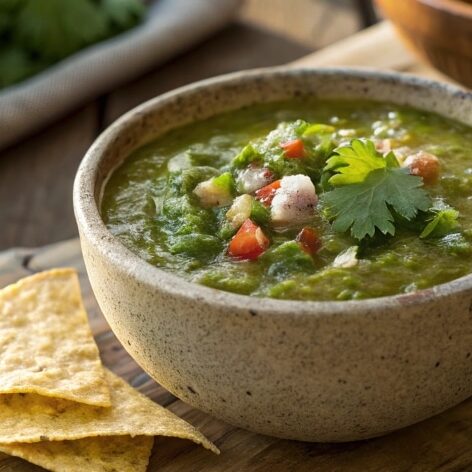
Easy Homemade Salsa Verde
Few things in a kitchen bring the same spark of freshness and authenticity as preparing an easy homemade salsa verde. This Mexican classic is bright, tangy, and just the right amount of spicy. Made with roasted jalapeno, fresh tomatillos, onion, garlic, and lime, it adds a punch of flavor to everything from cheesy chicken enchiladas to a simple bowl of tortilla chips. Whether you are looking to master a traditional verde recipe for taco night, searching for a topping for green chili chicken, or just want to know how to make salsa that tastes like it came from a family kitchen in Mexico, this guide will walk you through every detail.
Why Salsa Verde Deserves a Place in Your Kitchen
Salsa verde is not just another dip. It is a transformative sauce that can change the way your meal tastes and feels. With a base of tomatillos, its flavor is naturally zesty, which balances beautifully with smoky roasted peppers. A spoonful can brighten up a Mexican casserole, add depth to grilled meats, or make a breakfast scramble feel gourmet. It works as a dip, a marinade, a topping, or even as the secret ingredient that ties a dish together. Once you try this homemade salsa verde, you will want to keep a jar of it in your refrigerator at all times.
Ingredients You Will Need
The heart of salsa verde lies in simplicity. Fresh, natural ingredients combine to create something extraordinary. To make this recipe you will need:
- 1 pound fresh tomatillos, husked and rinsed
- 2 roasted jalapeno peppers (or more for extra heat)
- 1 small white onion, peeled and chopped
- 2 cloves garlic
- 1/2 cup fresh cilantro leaves
- Juice of 1 lime
- 1 teaspoon salt (to taste)
- 1/4 cup water (optional, for thinning)
Step-by-Step Instructions
Step 1: Roast the Vegetables
Start by roasting the tomatillos, jalapenos, garlic, and onion. You can place them under a broiler, on a grill, or in a dry skillet. Roasting enhances their flavor, giving your salsa a depth you cannot achieve with raw ingredients. A roasted jalapeno adds a smoky complexity that balances the tartness of tomatillos.
Step 2: Blend the Ingredients
Once the vegetables are roasted and slightly charred, transfer them to a blender or food processor. Add cilantro, lime juice, and salt. Blend until smooth. If the texture is too thick, add a splash of water. This creates a smooth yet slightly rustic sauce that is perfect for dipping or spooning over main dishes.
Step 3: Adjust Seasoning
Taste your salsa verde and adjust seasoning. If you prefer more heat, add another roasted jalapeno. If you want more tang, squeeze in more lime juice. Salt balances everything, so add a pinch more if needed.
Step 4: Chill and Serve
Although salsa verde can be served warm, it tastes even better once it has chilled in the refrigerator for at least 30 minutes. This resting time allows the flavors to meld together. Serve it with tortilla chips, spoon it over green chili chicken, or drizzle it on cheesy chicken enchiladas for an unforgettable meal.
Serving Ideas
- With chips: The most classic way to enjoy salsa verde is as a dip for crispy tortilla chips.
- On tacos: A drizzle on carne asada, chicken, or fish tacos elevates them instantly.
- With enchiladas: Pour it generously over cheesy chicken enchiladas for the ultimate comfort food.
- In casseroles: Use it as a base for a hearty Mexican casserole to give the dish a rich, tangy foundation.
- With grilled meats: Spoon it over pork, steak, or chicken to add brightness and zing.
Tips for Success
When making salsa verde, freshness is key. Use tomatillos that are firm and bright green. If roasting indoors, line your baking sheet with foil to catch the juices and make cleanup easier. Always taste before serving and adjust with lime and salt. If you want to make a milder version, use fewer jalapenos or remove their seeds before roasting. If you prefer a richer flavor, try roasting the tomatillos until their skins are blistered and browned.
Variations You Can Try
One of the beauties of salsa verde is how adaptable it is. Here are some variations to explore:
- Creamy Salsa Verde: Blend in a ripe avocado for a creamy, rich texture.
- Spicy Salsa Verde: Add roasted serrano peppers along with jalapenos for a fiery kick.
- Chunky Salsa Verde: Instead of blending fully, pulse the mixture to leave it slightly chunky.
- Verde Recipe with Herbs: Add a handful of fresh mint or parsley along with cilantro for a unique twist.
How To Make Salsa Ahead of Time
If you are hosting guests, salsa verde can be prepared in advance. Store it in an airtight container in the fridge for up to 5 days. Its flavor actually improves as it rests. For longer storage, freeze it in small containers or ice cube trays. Defrost overnight in the fridge and stir well before serving.
Pairing Salsa Verde with Meals
Pairing salsa verde with meals is easy because it works with so many foods. Spoon it over grilled chicken for a green chili chicken dinner. Add it to rice bowls for extra zest. Use it as a topping for nachos, quesadillas, or huevos rancheros. Combine it with sour cream for a creamy dip or swirl it into guacamole for a refreshing twist. This easy homemade salsa will quickly become the highlight of your weeknight meals.
Common Mistakes to Avoid
- Not roasting the vegetables: Skipping this step results in a flat flavor.
- Over-blending: Salsa verde should have texture. Avoid turning it into a watery sauce.
- Under-seasoning: Lime and salt bring out the flavors. Do not be afraid to add more.
- Using old tomatillos: Tomatillos that are soft or discolored will affect the taste.
Nutrition Facts
Salsa verde is naturally low in calories, fat-free, and packed with vitamin C from tomatillos and lime. It is a healthy way to add flavor without guilt. A serving of about two tablespoons contains roughly 15 calories and less than 1 gram of fat, making it a perfect condiment for any meal.
FAQs
What is the difference between salsa verde and red salsa?
The main difference is the base ingredient. Salsa verde uses tomatillos, giving it a green color and tangy flavor, while red salsa uses red tomatoes.
Can I make salsa verde without roasting?
Yes, you can blend raw tomatillos, jalapenos, and onions for a fresh and sharp version. However, roasted salsa verde has a deeper and more balanced flavor.
Can I use salsa verde for baking?
Yes, salsa verde is perfect for baked dishes. Pour it over enchiladas, add it to a Mexican casserole, or use it as a cooking sauce for meats.
How long does homemade salsa verde last?
It lasts up to 5 days in the refrigerator and up to 3 months in the freezer. Always store in an airtight container.
Final Thoughts
Salsa verde is one of those recipes that prove simplicity can create magic in the kitchen. With just a handful of ingredients and a few steps, you can prepare a sauce that tastes vibrant, refreshing, and authentic. Whether you are making cheesy chicken enchiladas, a green chili chicken skillet, or simply looking for an easy homemade salsa for chips, this verde recipe will always deliver. Try it today and see why it has been a beloved part of Mexican cooking for generations.
Easy Homemade Salsa Verde
Ingredients
Main Ingredients
- 1 pound tomatillos fresh, husked and rinsed
- 2 jalapeno peppers roasted, or more to taste
- 1 small white onion peeled and chopped
- 2 cloves garlic
- 1/2 cup cilantro leaves fresh
- 1 lime juiced
- 1 tsp salt to taste
- 1/4 cup water optional, for thinning
Instructions
- Roast the tomatillos, jalapenos, garlic, and onion under a broiler, on a grill, or in a dry skillet until slightly charred.
- Transfer the roasted vegetables to a blender. Add cilantro, lime juice, and salt. Blend until smooth. Add water if needed to thin the texture.
- Taste and adjust seasoning with more lime or salt. Add an extra jalapeno if you prefer more heat.
- Chill in the refrigerator for at least 30 minutes before serving to allow flavors to meld.

